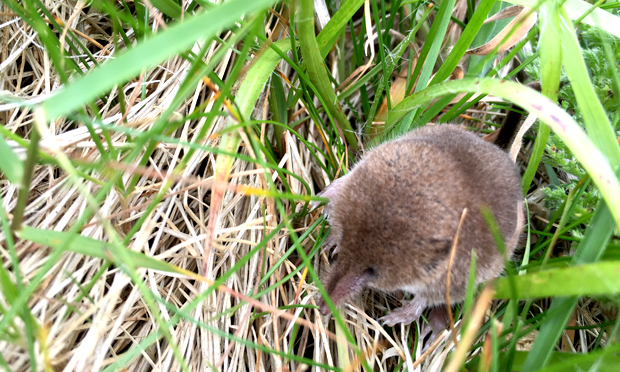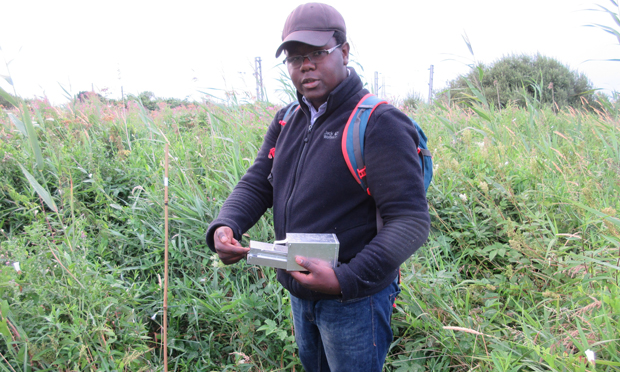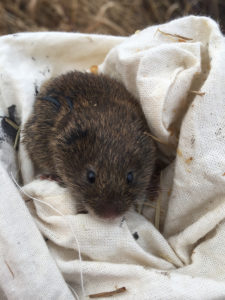Vole patrol: Conservationist takes to Marshes to find out about its shrews and other small mammals

A pygmy shrew nestled in Walthamstow Marshes. Photograph: Nathaniel Legall
It is shortly before 6am and Nathaniel Legall is checking live animal traps on Walthamstow Marshes.
A conservationist and London Wildlife Trust ranger, Legall is an expert in the small mammals of the Marshes. His traps are humane and nigh on luxurious for the animals that get caught in them – he describes them as being like “hotels” with all the food and bedding their temporary occupants need for a brief if unintended stay. What he captures, he releases, the aim being to scientifically survey the area to discover what species live here and the size of their respective populations.
Legall placed his traps the night before in one of the more inaccessible reaches of the Marshes, and the denseness of the surrounding vegetation means they initially prove quite difficult to find. When he does finally locate them, the result is anticlimactic – they are empty. But he insists the area is far from devoid of life. Small mammals captured by him so far have included field vole, bank vole, common shrew, pygmy shrew and wood mouse.
He has also found evidence of water vole. Within living memory this species has gone from being relatively widespread to critically endangered in London. Depressingly, Legall estimates there are only about 12 such voles left on the Marshes, meaning they are soon likely to go extinct locally unless action is taken to bolster their numbers. Legall says there have also been sightings in the area of invasive mink, whose favoured prey is water voles.
Shrews and voles might seem like trifling animals and, indeed, they are often overlooked precisely because their size and shyness make them practically impossible to see.
But Legall says they are barometers of the ecological health of this stretch of the Lea Valley. What’s more, they could represent one of the last remaining links back to an ancient time when far larger animals roamed the Marshes.

Legall, hard at work. Photograph: Nathaniel Legall
“If you were standing on this spot 10,000 years ago, you might have seen bison roaming across the Lammas plain,” Legall says. “If you walked along the channel of the Lea, you might hear a beaver plopping into the river.
“What you see now is a fragment of what was here, but that’s the case for much of the UK – there’s not a single square mile that hasn’t been interfered with.”
Small remnants of this lost landscape remain. Bison bones have been uncovered on the Marshes, as has ancient buried wood showing evidence of having been gnawed away at by beavers.
Legall hopes to one day carry out genetic studies to determine whether the voles and shrews that inhabit the area now are descendants of those that were here in the time of the bison or whether their ancestors were comparative newcomers – perhaps stowaways on narrowboats or passengers on driftwood that carried them down the Lea Valley’s waterways.
Legall has researched the pygmy shrew population on the island of Lundy in the Bristol Channel. He describes the Marshes as another kind of island, one surrounded by city streets, which, for the purposes of much wildlife, are as unnavigable as the stormiest sea.
“The small mammals are massively important indicators of biodiversity, because the fact that they exist here shows there is a variety of insects, and the insects show there’s a variety of plant life there,” he says. “The fact there are small mammals here shows that Walthamstow Marshes is massively important for biodiversity and is worth protecting.
“Not only is it massively precious and chock-full of biodiversity, it’s also smack bang in the middle of Walthamstow and Hackney. It is located in one of the most urbanised areas of the country, so what I want to do is get the word out and show people why Walthamstow Marshes is important.”

On a practical level, Legall is working to improve habitat connectivity between the Marshes and neighbouring reservoirs, which are currently being turned into an official nature reserve by the London Wildlife Trust.
The opening of the reserve next year looks set to prompt renewed interest in a landscape that, while it is no wilderness, is perhaps the closest thing to Yellowstone on Hackney’s doorstep.
